1995 BUICK REGAL heater
[x] Cancel search: heaterPage 76 of 340
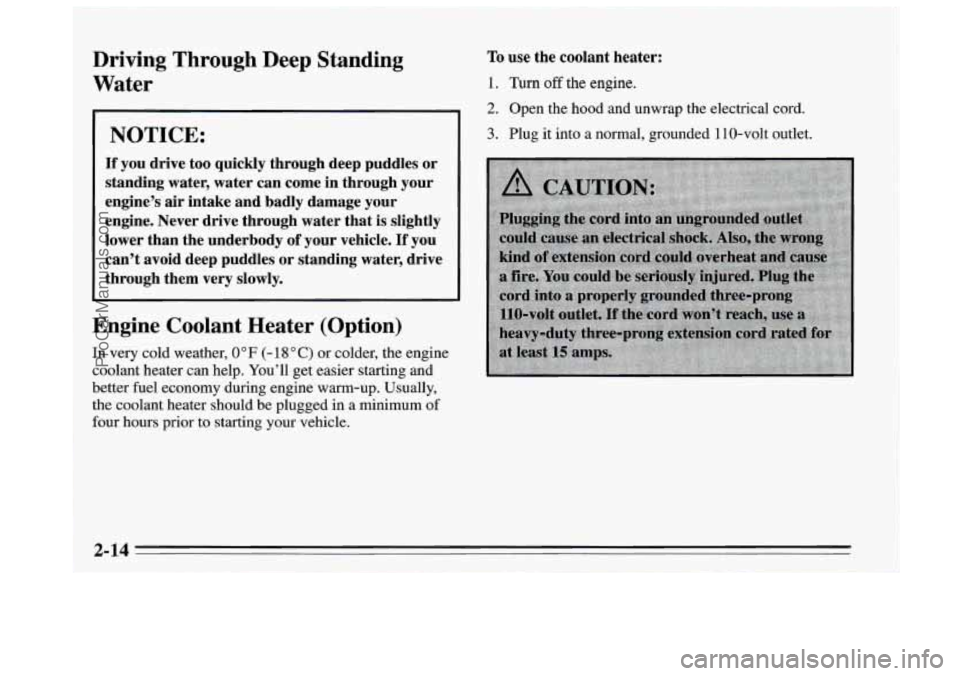
Driving Through Deep Standing
Water
NOTICE:
If you drive too quickly through deep puddles or
standing water, water can come in through your
engine’s
air intake and badly damage your
engine. Never drive through water that
is slightly
lower than the underbody
of your vehicle. If you
can’t avoid deep puddles or standing water, drive
through them very slowly.
Engine Coolant Heater (Option)
To use the coolant heater:
I. Turn off the engine.
2. Open the hood and unwrap the electrical cord.
3. Plug it into a normal, grounded 110-volt outlet.
In very cold weather,
0°F (- 18 O C) or colder, the engine
coolant heater can help. You’ll get easier starting and
better fuel economy during engine warm-up. Usually,
the coolant heater should be plugged in a minimum
of
four hours prior to starting your vehicle.
2-14
ProCarManuals.com
Page 77 of 340
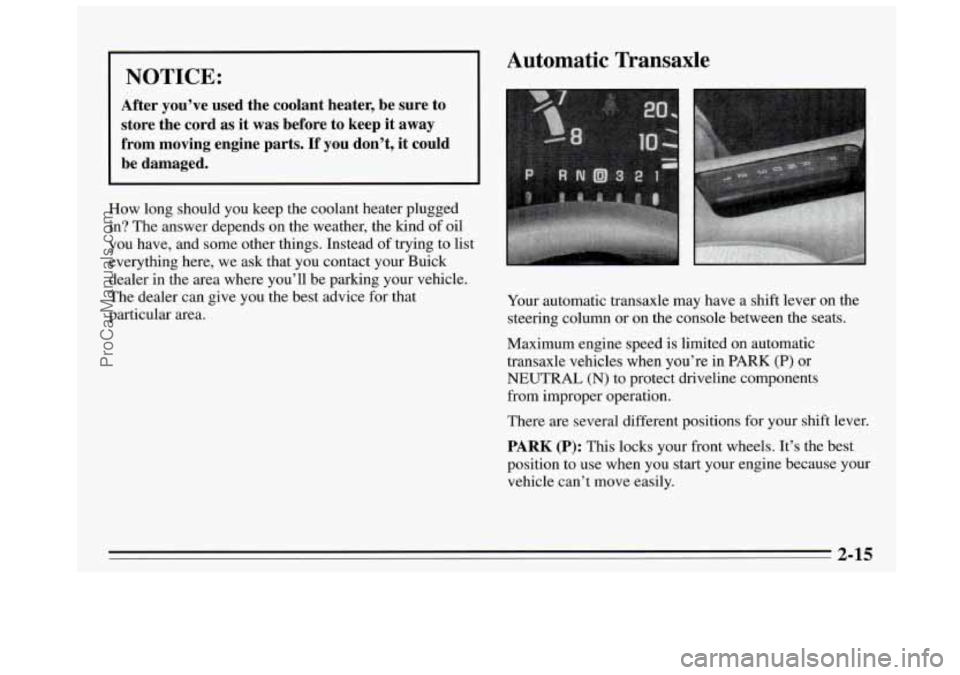
NOTICE:
After you’ve used the coolant heater, be sure to
store the cord as it was before to keep it away
from moving engine parts. If you don’t, it could
be damaged.
How long should you keep the coolant heater plugged
in? The answer depends on the weather, the kind of oil
you have, and some other things. Instead of trying to list
everything here, we ask that you contact your Buick
dealer in the area where you’ll be parking your vehicle.
The dealer can give you the best advice for that
particular area.
Automatic Transaxle
Your automatic transaxle may have a shift lever on the
steering column or on the console between the seats.
Maximum engine speed is limited on automatic
transaxle vehicles when you’re in
PARK (P) or
NEUTRAL (N) to protect driveline components
from improper operation.
There are several different positions for your shift lever.
PARK (P): This locks your front wheels. It’s the best
position to use when you start your engine because your vehicle can’t move easily.
2-15
ProCarManuals.com
Page 95 of 340
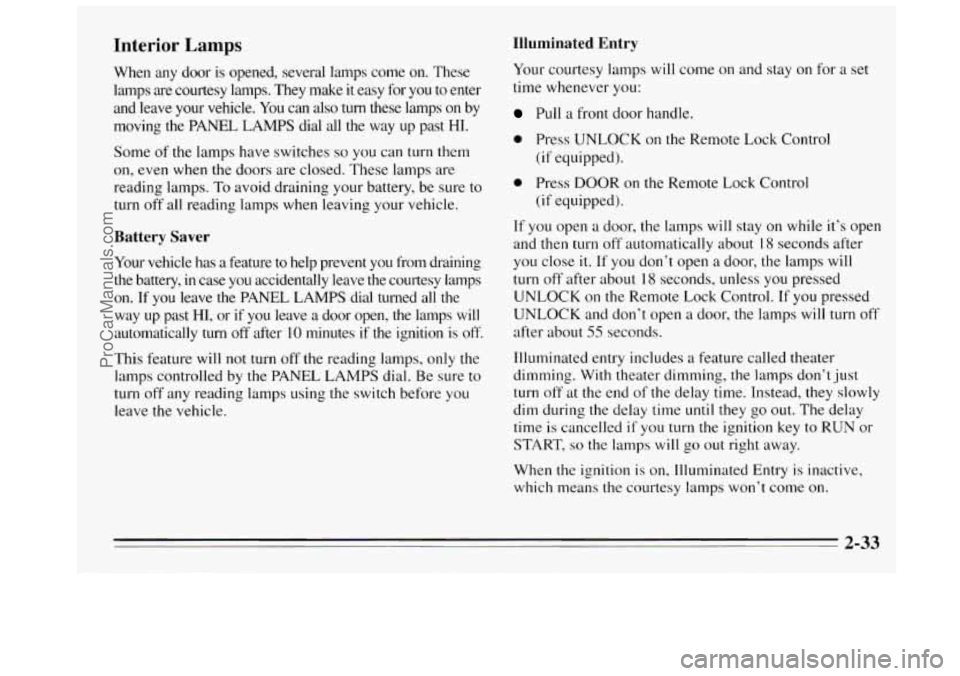
Interior Lamps
When any door is opened, several lamps come on. These
lamps
are courtesy lamps. They make it easy for you to enter
and leave your
vehcle. You can also turn these lamps on by
moving the PANEL LAMPS dial all the way up past
HI.
Some of the lamps have switches so you can turn them
on, even when the doors are closed. These lamps are
reading lamps.
To avoid draining your battery, be sure to
turn
off all reading lamps when leaving your vehicle.
Illuminated Entry
Battery Saver
Your vehicle has a feature to help prevent you from draining
the battery, in case you accidentally leave the courtesy lamps
on. If you leave the PANEL LAMPS dial turned all the
way up past
HI, or if you leave a door open, the lamps will
automatically
turn off after 10 minutes if the ignition is off.
This feature will not turn off the reading lamps, only the
lamps controlled by
the PANEL LAMPS dial. Be sure to
turn off any reading lamps using the switch before you
leave the vehicle. Your
courtesy lamps will come on and stay on for
a set
time whenever you:
Pull a front door handle.
0 Press UNLOCK on the Remote Lock Control
(if equipped).
0 Press DOOR on the Remote Lock Control
(if equipped).
If you open
a door, the lamps will stay on while it’s open
and then turn off automatically about 18 seconds after
you close it. If you don’t open a door,
the lamps will
turn off after about 18 seconds, unless you pressed
UNLOCK
on the Remote Lock Control. If you pressed
UNLOCK and don’t open
a door, the lamps will turn off
after about 55 seconds.
Illuminated entry includes a feature called theater
dimming. With theater dimming,
the lamps don’t just
turn off at the end of the delay time. Instead, they slowly
dim during the delay time
until they go out. The delay
time
is cancelled if you turn the ignition key to RUN or
START,
so the lamps will go out right away.
When the ignition is on, Illuminated Entry is inactive,
which means the courtesy lamps won’t come on.
ProCarManuals.com
Page 120 of 340
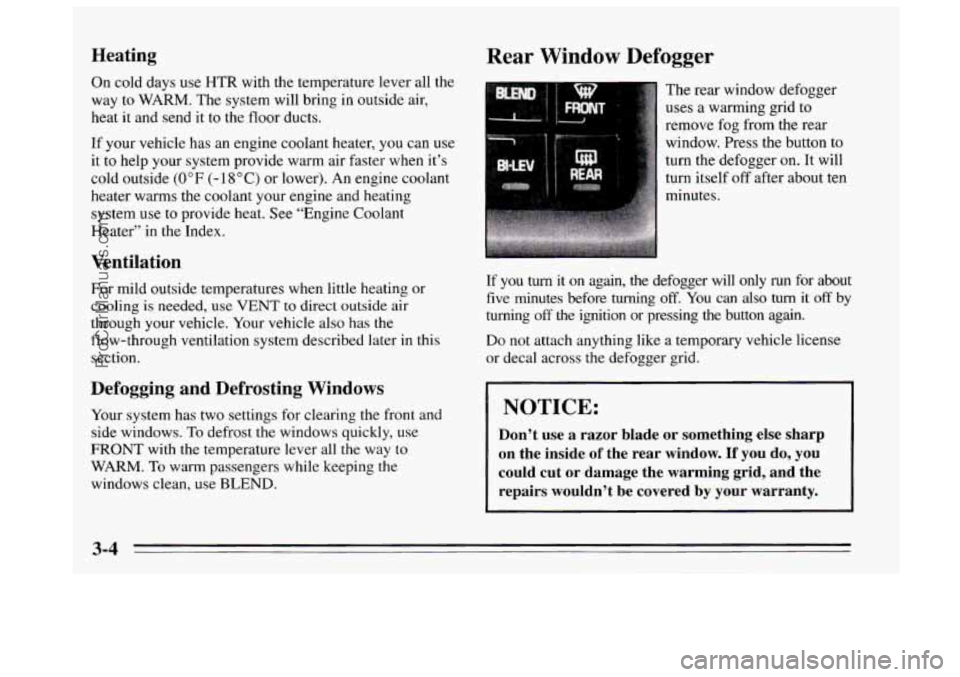
Heating
On cold days use HTR with the temperature lever all the
way to WARM. The system will bring in outside air,
heat it and send it to the floor ducts.
If your vehicle has an engine coolant heater, you can
use
it to help your system provide warm air faster when it’s
cold outside
(0°F (-18°C) or lower). An engine coolant
heater warms the coolant your engine and heating
system use to provide heat. See “Engine Coolant
Heater” in
the Index.
Ventilation
For mild outside temperatures when little heating or
cooling
is needed, use VENT to direct outside air
through your vehicle. Your vehicle also
has the
flow-through ventilation system described later in this
section.
Defogging and Defrosting Windows
Your system has two settings for clearing the front and
side windows.
To defrost the windows quickly, use
FRONT with the temperature lever all the way to
WARM.
To warm passengers while keeping the
windows clean, use
BLEND.
Rear Window Defogger
The rear window defogger
uses
a warming grid to
remove fog from the rear
window. Press the button to
turn the defogger on. It will
turn itself off after about ten
minutes.
If you
turn it on again, the defogger will only run for about
five minutes before turning
off. You can also turn it off by
turning
off the ignition or pressing the button again.
Do not attach anything like a temporary vehicle license
or decal across the defogger grid.
1 NOTICE:
Don’t use a razor blade or something else sharp
on the inside
of the rear window. If you do, you
could cut or damage the warming grid, and the
repairs wouldn’t be covered by your warranty.
3-4
ProCarManuals.com
Page 121 of 340
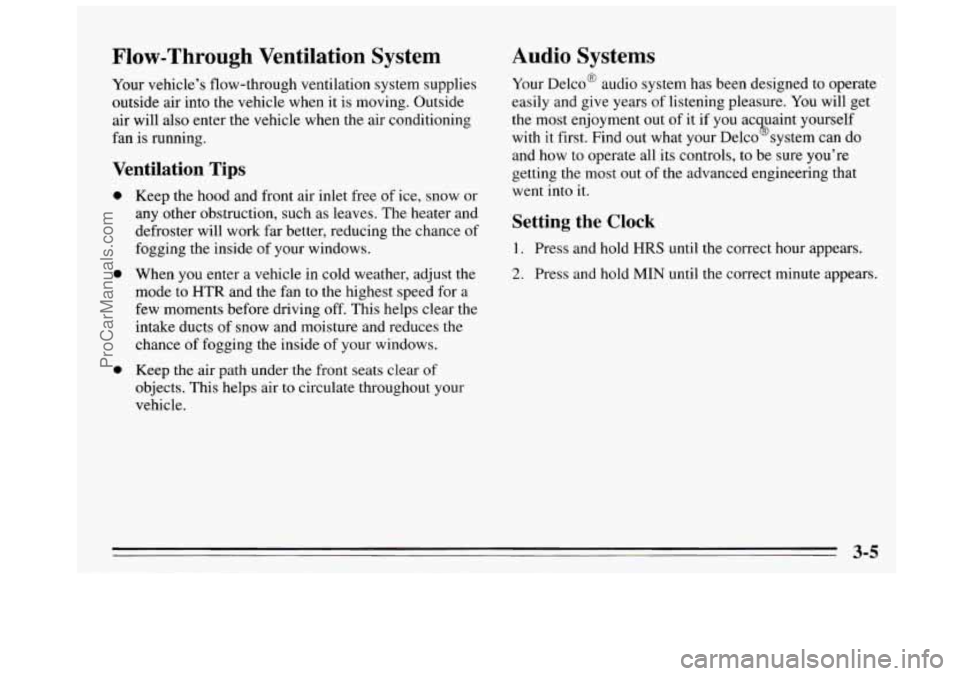
Flow-Through Ventilation System
Your vehicle’s flow-through ventilation system supplies
outside air into the vehicle when it is moving. Outside
air will also enter the vehicle when the air conditioning
fan is running.
Ventilation Tips
e
e
e
Keep the hood and front air inlet free of ice, snow or
any other obstruction, such as leaves. The heater and
defroster will work far better, reducing the chance of
fogging the inside of your windows.
When you enter a vehicle in cold weather, adjust the
mode
to HTR and the fan to the highest speed for a
few moments before driving off. This helps clear the
intake ducts of snow and moisture and reduces the
chance of fogging the inside
of your windows.
Keep the air path under the front seats clear
of
objects. This helps air to circulate throughout your
vehicle.
Audio Systems
Your Delco@ audio system has been designed to operate
easily and give years
of listening pleasure. You will get
the most enjoyment out of it
if you ac uaint yourself
with it first. Find out what your Delco system can do
and how
to operate all its controls, to be sure you’re
getting the most out of the advanced engineering that
went into it.
gs
Setting the Clock
1. Press and hold HRS until the correct hour appears.
2. Press and hold MIN until the correct minute appears.
ProCarManuals.com
Page 163 of 340
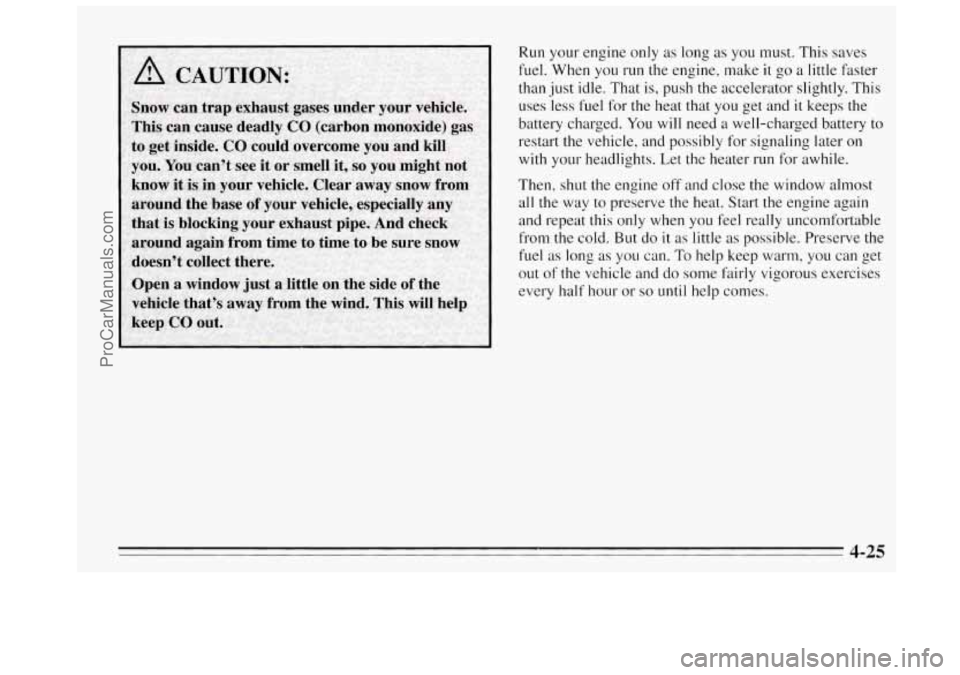
Run your engine only as long as you must. This saves
fuel. When you
run the engine, make it go a little faster
than
just idle. That is, push the accelerator slightly. This
uses ‘less fuel for the heat that you get and it keeps the
battery charged. You will need a well-charged battery to
restart the vehicle, and possibly .for signaling later on
with
your headlights. Let the heater run for awhile.
Then, shut the engine off and close the window almost
all the way to preserve the heat. Start
the engine again
and repeat this only when
you feel really uncomfortable
from the cold.
But do it as little as possible. Preserve the
fuel as long as you can. To help keep warm, you can get
out
of the vehicle and do some fairly vigorous exercises
every half hour or
so until help comes.
4-25
ProCarManuals.com
Page 189 of 340
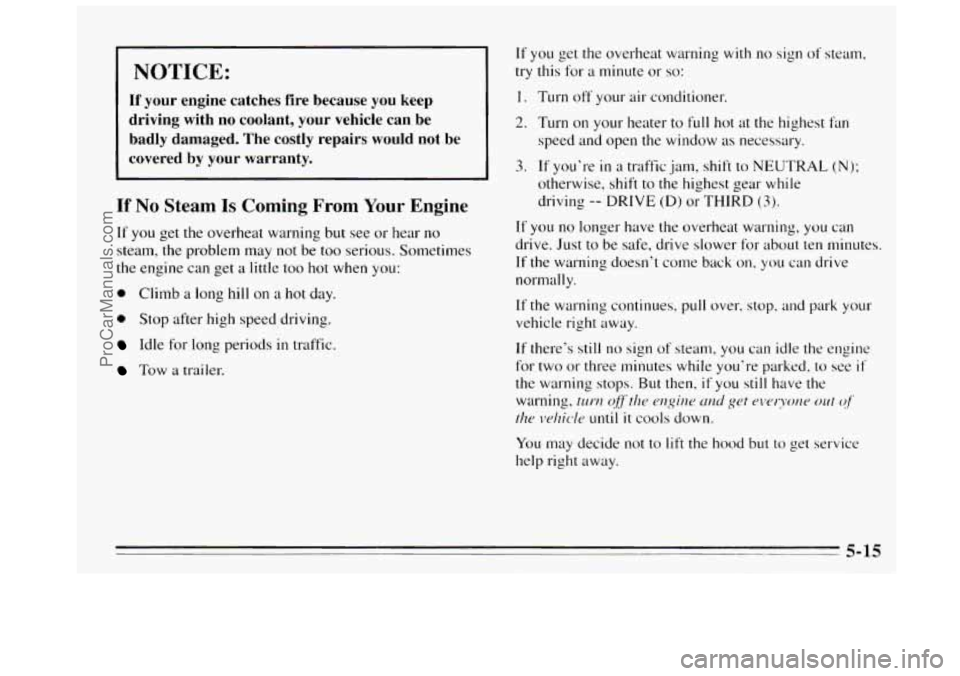
NOTICE:
If your engine catches fire because you keep
driving with no coolant, your vehicle can be
badly damaged. The costly repairs would not be
covered
by your warranty.
If No Steam Is Coming From Your Engine
If you get the overheat warning but see or hear no
steam, the problem may not be too serious. Sometimes
the engine can get a little too
hot when you:
0 Climb a long hill on a hot day.
0 Stop after high speed driving.
Idle for long periods in traffic.
Tow a trailer.
If you get the overheat warning with no sign of steam,
try this for a minute or so:
1. Turn off your air conditioner
2. Turn on your heater to full hot at the highest fan
speed and open the window as necessary.
3.
If you’re in a traffic jam, shift to NEUTRAL (N);
otherwise, shift to the highest gear while
driving
-- DRIVE (D) or THIRD (3).
If you no longer have the overheat warning, you can
drive. Just to be safe, drive slower for about ten minutes.
If the warning doesn’t come back
on, you can drive
normally.
If the warning continues, pull over, stop, and park your
vehicle right away.
If there’s still
no sign of steam, you can idle the engine
for two
or three minutes while you’re parked, to see if
the warning stops. But then, if you still have the
warning,
rwrl ojftlw engine ~-rnd get owryotw out of’
the vehicle until it cools down.
You may decide not to lift the hood but
help right away. to
get service
5-15
ProCarManuals.com
Page 191 of 340
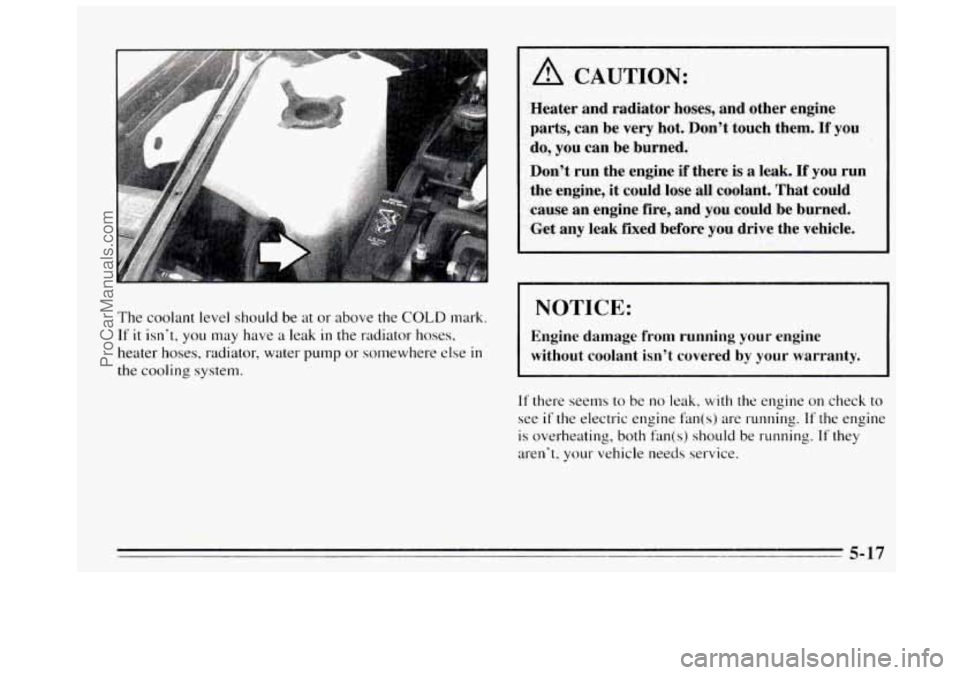
The coolant level should be at or above the COLD mark.
If it isn’t, you may have a leak in the radiator hoses,
heater hoses, radiator, water
pump or somewhere else in
the cooling system.
I A CAUTION:
Heater and radiator hoses, and other engine
parts, can be very hot. Don’t touch them.
If you
do,
you can be burned.
Don’t run the engine
i€ there is a leak. If you run
the engine, it could lose all coolant. That could
cause an engine fire, and you could be burned.
Get any leak fixed before you drive the vehicle.
NOTICE:
Engine damage from running your engine
without coolant isn’t covered
by your warranty.
If there seems to be no leak, with the engine on check to
see
if the electric engine fan(s) are running. If the engine
is overheating, both fan(s) should be running. If they
aren’t, your vehicle needs service.
ProCarManuals.com